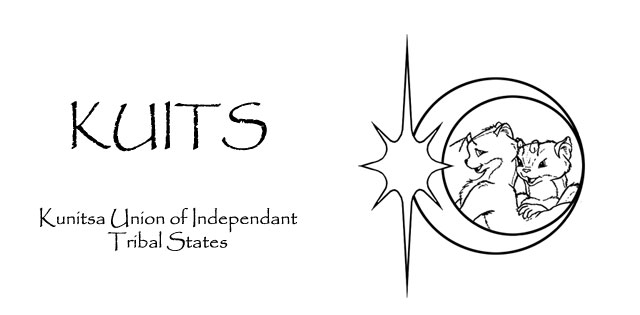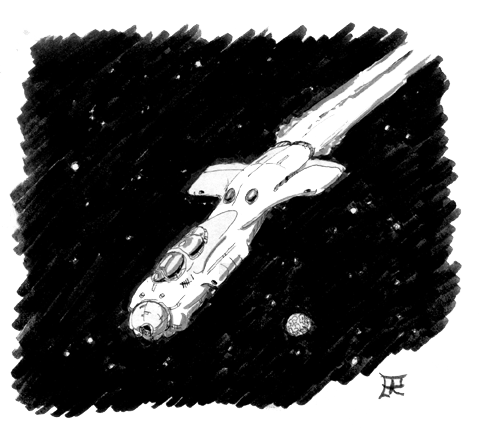

The Kunitsa System, A brief history and overview. Goldleaf
(Note: Information included in this document may not be cleared for distribution outside the Kunitsa Informats. It has been prepared to inform internal staff of the Kunitsa Informats and should be considered EYES ONLY. Please do not discuss this document telepathically.)
 I
have prepared this report for the Space Tree Visitors Informat. I have attempted
to include any important historical events in the development of the Kunitsa
system and it's major industrial, trade and commercial establishments. I have
access to extensive historical data from sources including the Combined Council
of Tribal Elders historians and recorders, and the Overdirectorial Informat
records division. The time line of this report deals mainly with events happening
after the original Zhodani colonies were established in the system, though I
could have gone much farther back in time if I considered such information would
have been useful. My years of experience in both the Trade Directorial and the
Security Directorial have convinced me that visitors have little interest in
the everyday existence of our tribes, so I have avoided including such data
in this report. Information regarding the original Kunitsa-Zhodani collateral
colonization agreements and the Free Information Exchange Accord are included
only to provide an explanation for the rapid economic and technological development
of Kunitsa. The opinions expressed herein to for reasons behind the supportive
activities of the Zhodani Kunitsa Uplift projects is the popular consensus of
the Combined Tribal Elders, based on ongoing observation of the Zhodani peoples
and culture. I have used the Imperial calendar as a standard dating system in
this report, though I can convert the dates to any other calendar if requested.
I hope this report will be useful in preparing information for visitors, though
I expect the Visitors Informat will be editing and embellishing my data.
I
have prepared this report for the Space Tree Visitors Informat. I have attempted
to include any important historical events in the development of the Kunitsa
system and it's major industrial, trade and commercial establishments. I have
access to extensive historical data from sources including the Combined Council
of Tribal Elders historians and recorders, and the Overdirectorial Informat
records division. The time line of this report deals mainly with events happening
after the original Zhodani colonies were established in the system, though I
could have gone much farther back in time if I considered such information would
have been useful. My years of experience in both the Trade Directorial and the
Security Directorial have convinced me that visitors have little interest in
the everyday existence of our tribes, so I have avoided including such data
in this report. Information regarding the original Kunitsa-Zhodani collateral
colonization agreements and the Free Information Exchange Accord are included
only to provide an explanation for the rapid economic and technological development
of Kunitsa. The opinions expressed herein to for reasons behind the supportive
activities of the Zhodani Kunitsa Uplift projects is the popular consensus of
the Combined Tribal Elders, based on ongoing observation of the Zhodani peoples
and culture. I have used the Imperial calendar as a standard dating system in
this report, though I can convert the dates to any other calendar if requested.
I hope this report will be useful in preparing information for visitors, though
I expect the Visitors Informat will be editing and embellishing my data.
First Contact:
Our people first contacted the Zhodani colonists on Kunitsa in 456. The original Zhodani survey landed in 394 on Kunitsa. The same survey team also explored Laska, our sister planet. A colony was established on Kunitsa in 416, primarily as a support establishment for the naval base being constructed by the Zhodani on Laska. The Zhodani were observed for the next 40 years before the first Combined Council of Tribal Elders representatives contacted the directors of the colony. Considerable agricultural exploitation had occurred, including the clearing of several thousand acres of prime climax forest. Natural water systems had also been manipulated and in some cases polluted. Though our people tend to keep to themselves when other groups establish colonies, the negative impact on our living environments forced action. As the legends say, sometimes you must come forward, like Bright; growl and show your teeth to confront a problem. The Zhodani Colonial Directorial was surprised to find that they were sharing the planet with another 'sentient' species. I have discovered that this is a common occurrence when other 'sentient' species encounter our people. This is likely due to the fact that, as a people, we do not develop industry, manufacture things, or construct structures. We choose to exist in the most simple, some might say 'primitive' ways, with the least possible impact on the environment. Like any species, our population and distribution is determined by environmental forces, such as food supply. For hunting carnivores, maintaining large forested areas not only provides cover for ample prey, but optimal housing opportunities for our people. We had it easier then some of our kin on other worlds, for our inherent telempathy, which allowed us to monitor the colonists and also learn to communicate with them, was recognized as a trait of a 'sentient' species. The Zhodani communicators were amazed that they could not detect us before we initiated contact. It was found that this was due to a fundamental difference in the way we, and other species, including the Zhodani, use their mental communication abilities.
Digital and Analog Mental Communication:
At this point I would like to take the time to explain, in simple terms, this difference between our mental communication abilities and most other species, including the Zhodani. Many species develop a vocal language early in their development, and this effects all other forms of inter-being communication. Though the ability to communicate mentally may be innate, a developing individual is likely to learn other common means of communication first, and then implement any other means of communicating using the established knowledge. This means that many species communicate mentally with that same language they use vocally, that is, by thinking in the form of words and sentences. Thus, the stream of mental communication is broken up into bits of information, much like digital data. It is possible to also read mood, or 'feelings' mentally, but to establish any real information, a being using digital mental communication, or 'telepathy' as it is commonly known, must be able to understand the 'bits' of the digital stream. A trained telepath, like a Zhodani communicator, can detect such bursts of mental energy and after monitoring them for a time, begin to 'translate' the language of the other being has been detected. The Zhodani had much experience with other 'telepathic' species, and so were confused as to why they could not detect and monitor our people, when they had been living close by for 40 years.
The reason that most telepathic species cannot detect one of us is that our mental abilities developed originally as a basic sense, before we began using it for communication. We continually scan the electromagnetic spectrum, sorting out patterns that indicate mental activity. Animal minds produce a continuous stream of radiated energy, which is constantly changing. We can separate, compare and analyze these 'analog' signals with our own minds. This enables us to see through other being's eyes, experience what they are experiencing with their other senses, feel what they feel, remember what they remember, and even share dreams. Because our people are born with this ability, and use it from birth, we have established this method for normal communication between ourselves. As our tribes formed, and other means of communication become necessary, we developed vocal and visual signals, and writing, but we continued to communicate mentally in the same way, by listening to and modifying our own 'analog' streams of radiated energy. It is likely that the Zhodani communicators could receive the 'analog' streams we were transmitting between our people, but they had no way to 'decode' the data. Our mental communication, which is sometimes referred to as 'tel-empathy', to indicate the 'analog' nature of the signal process, would appear to many telepaths as 'noise' from the collective minds of 'non-sentient' animals. As Soft tells us, from our legends, we must always be willing to study and understand everything that is around us, to improve our advantage. During the years we were monitoring the Zhodani colonists, some of the tribal communicators learned the Zhodani language, and were able to teach it to many of our people. By the time our elders decided to contact the colonists, communication could be easily established. The Zhodani species are cultural users of telepathy, and recognized our people as 'sentient' and as the indigenous species of the planet. The Zhodani do not establish colonies on worlds inhabited by other species they consider 'sentient', so negotiations began to determine what presence the Zhodani would have in the Kunitsa system.
Expansion, Trade and Technology:
 The
original negotiations between Kunitsa and the Zhodani brought to light the fact
that the Zhodani had found other established tribes of our people on other worlds
they had explored and colonized in other sectors. They immediately suggested
that we send representatives to these worlds to assist our kin with first contact
efforts. On each world inhabited by our people, the Zhodani and any other species
having established a colony would have to negotiate a proper settlement with
the indigenous population. As Warm, of the First Tribe would advise " if
a situation is to your advantage, do not do anything to upset it". Our
people had not found it necessary to initiate contact with the colonists on
these other worlds, because they had not acted in any way which our people deemed
as unacceptable. The response to the information gathered from these negotiations
impressed the Zhodani Council Colonial Directorate, and they proposed to make
Kunitsa the governmental center for all the worlds inhabited by our people within
Zhodani territory. Though such forms of organization are not typical for our
peoples, representatives of the Tribal Elders from all such worlds met in Kunitsa
City and established the Kunitsa Union of Independent Tribal States, a simple
alliance of worlds which may send representatives to the Kunitsa City central
lodge. Kunitsa City was established on the site of the original Zhodani colony
that same year. By 486 the city had a resident population of over 100,000, with
approximately 3000 Zhodani living with our people. Efficient, low impact manufacturing
facilities produced construction materials, including metal alloys and carbon-fiber
reinforced polymers. Other industrial establishments produced advanced electronics,
including medical monitoring and communication equipment and computers; and
airborne and ground personal transportation vehicles and precision load handlers.
In 498, an experimental production facility on Kiaklets successfully created
the first braided diamond fiber construction material. The original process
was developed by the Zhodani, but every attempt to mass produce the material
had failed. The process was nearly automated, but the critical step that allowed
the crystallized micro-fibers to align and grow as a bonded unit cold not be
done by ordinary micro-manipulation techniques. Using traditional manual controlled
micro-manipulators, certain individuals of our people were able align the crystals.
Once the alignment process was completed, the process of growing the bonded
strands became trivial. No solid explanation for how some of our people could
accomplish such a delicate task has been forthcoming. One theory suggested by
Zhodani telekinesis advocates is that our people are actually aligning the molecules
with telekinesis, not the micro-manipulators. This is considered unlikely by
our own investigators, as none of the workers who perform this difficult task
have been trained in telekinetic skills, and telekinesis abilities are not common
in our people.
The
original negotiations between Kunitsa and the Zhodani brought to light the fact
that the Zhodani had found other established tribes of our people on other worlds
they had explored and colonized in other sectors. They immediately suggested
that we send representatives to these worlds to assist our kin with first contact
efforts. On each world inhabited by our people, the Zhodani and any other species
having established a colony would have to negotiate a proper settlement with
the indigenous population. As Warm, of the First Tribe would advise " if
a situation is to your advantage, do not do anything to upset it". Our
people had not found it necessary to initiate contact with the colonists on
these other worlds, because they had not acted in any way which our people deemed
as unacceptable. The response to the information gathered from these negotiations
impressed the Zhodani Council Colonial Directorate, and they proposed to make
Kunitsa the governmental center for all the worlds inhabited by our people within
Zhodani territory. Though such forms of organization are not typical for our
peoples, representatives of the Tribal Elders from all such worlds met in Kunitsa
City and established the Kunitsa Union of Independent Tribal States, a simple
alliance of worlds which may send representatives to the Kunitsa City central
lodge. Kunitsa City was established on the site of the original Zhodani colony
that same year. By 486 the city had a resident population of over 100,000, with
approximately 3000 Zhodani living with our people. Efficient, low impact manufacturing
facilities produced construction materials, including metal alloys and carbon-fiber
reinforced polymers. Other industrial establishments produced advanced electronics,
including medical monitoring and communication equipment and computers; and
airborne and ground personal transportation vehicles and precision load handlers.
In 498, an experimental production facility on Kiaklets successfully created
the first braided diamond fiber construction material. The original process
was developed by the Zhodani, but every attempt to mass produce the material
had failed. The process was nearly automated, but the critical step that allowed
the crystallized micro-fibers to align and grow as a bonded unit cold not be
done by ordinary micro-manipulation techniques. Using traditional manual controlled
micro-manipulators, certain individuals of our people were able align the crystals.
Once the alignment process was completed, the process of growing the bonded
strands became trivial. No solid explanation for how some of our people could
accomplish such a delicate task has been forthcoming. One theory suggested by
Zhodani telekinesis advocates is that our people are actually aligning the molecules
with telekinesis, not the micro-manipulators. This is considered unlikely by
our own investigators, as none of the workers who perform this difficult task
have been trained in telekinetic skills, and telekinesis abilities are not common
in our people.
 In
552, the Z.C.C.D. proposed to K.U.I.T.S. a plan to allow our people to establish
colonies on several Zhodani and allied client worlds. Our people would be allowed
to settle on prime territory on each world that agreed to the plan. Finding
willing colonists was easy, and over 100 new colonies were founded on worlds
all along the rift. At this time it became obvious to the Kunitsa Informats
that the Zhodani support of Kunitsa and our people was not purely charitable,
nor based solely on economic gains from potential trade and specialized industrial
development. Our people had become a useful strategic tool in the Zhodani political
arsenal, for our colonies would not only report activity on all worlds we had
settled, but those worlds could no longer be considered solely Zhodani clients,
as they were a part of K.U.I.T.S. Information gathered from our sources in the
Imperium and other established planetary federations indicate that the Zhodani
are not actively expansionist, but are actively securing their borders by any
means possible. The border wars of 589 had caused the Zhodani Councils to rethink
their strategy regarding client worlds. The more diverse the world controlling
authorities are in sectors surrounding their borders, the less likely those
worlds would be a target for encroachment from neighboring federations. A buffer
zone of 'independent' worlds was seen as the best defense barring actually occupying
and committing expensive fleet assets throughout the Consulate's neighboring
space. Our realization of this obvious diplomatic contrivance has provided a
logical explanation for the continuing support we have received from the Zhodani.
As Dark is often quoted in popular legend, "be alert for anything that
will give you an advantage, and keep quiet and still, lest you loose it."
In
552, the Z.C.C.D. proposed to K.U.I.T.S. a plan to allow our people to establish
colonies on several Zhodani and allied client worlds. Our people would be allowed
to settle on prime territory on each world that agreed to the plan. Finding
willing colonists was easy, and over 100 new colonies were founded on worlds
all along the rift. At this time it became obvious to the Kunitsa Informats
that the Zhodani support of Kunitsa and our people was not purely charitable,
nor based solely on economic gains from potential trade and specialized industrial
development. Our people had become a useful strategic tool in the Zhodani political
arsenal, for our colonies would not only report activity on all worlds we had
settled, but those worlds could no longer be considered solely Zhodani clients,
as they were a part of K.U.I.T.S. Information gathered from our sources in the
Imperium and other established planetary federations indicate that the Zhodani
are not actively expansionist, but are actively securing their borders by any
means possible. The border wars of 589 had caused the Zhodani Councils to rethink
their strategy regarding client worlds. The more diverse the world controlling
authorities are in sectors surrounding their borders, the less likely those
worlds would be a target for encroachment from neighboring federations. A buffer
zone of 'independent' worlds was seen as the best defense barring actually occupying
and committing expensive fleet assets throughout the Consulate's neighboring
space. Our realization of this obvious diplomatic contrivance has provided a
logical explanation for the continuing support we have received from the Zhodani.
As Dark is often quoted in popular legend, "be alert for anything that
will give you an advantage, and keep quiet and still, lest you loose it."
The development of the diamond-fiber construction material led to a proposal for the construction of an experimental tethered low-orbit space elevator system. A site was selected near Kunitsa City where a proper anchor could be cored to bedrock, and construction began in 580. The completed fiber cable was attached to an orbital station and the first complete round-trip of the elevator platform occurred 5 years later. The space elevator was in operation as a freight and passenger transport from 587 to 595 when the operation was halted to begin the more involved Space Tree project. The Space Tree was envisioned as a combination low-orbit space port with full outfitting and fueling services, cargo and passenger terminus, high speed space to surface transportation system and arcology containing complete infrastructure for all extra-planet trade and transportation enterprises. One thousand more diamond-fiber cables were anchored over the 100 acre circle that would be the base of the trunk. The original low-orbit station was replaced by a much larger platform with formed the base for the 10 level, 13,000,000 sq. meter space port. Between the fiber cables, a series of 30 high-speed elevators of various sizes, some multi-leveled and two large enough to transport entire 1000 ton starship hulls, all with inertial compensation, were constructed. The outer walls of the main trunk were covered with carbon-fiber enforced organic polymer concrete panels designed to flex with internal or external pressure to prevent cracking. Around the base of the trunk, an arcology was constructed to house offices, warehousing and manufacturing facilities, hotels, merchants and residential apartments for 10,000 workers, residents and visitors. The Space Tree was completed in 651, and has become the economic center of Kunitsa, as well as the new center of Kunitsa City, which remains the only modern population center on the world.
Home Skiltaire Character Generation Kunitsa and Environs Kunitsa Planetary Detail Kunitsa Space Tree